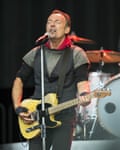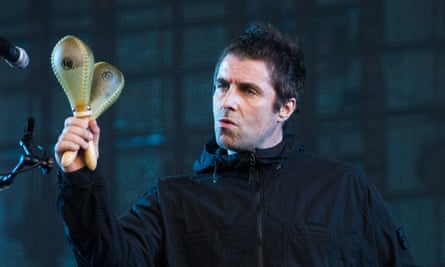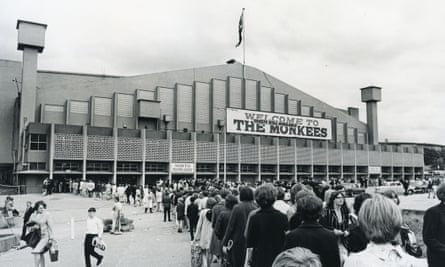Everyone – well, everyone in their right mind – prefers small gigs to big gigs. It’s a much nicer experience all round seeing an artist you love in a room with a few hundred people, than seeing them in an enormodome or a stadium. For a start, you feel like a participant rather than a spectator. But, sadly, there are artists who just don’t play small rooms (or if they do, you’ve got more chance of winning the Nobel peace prize than getting a ticket), so the enormodome or stadium is the only option.
If you write about music, your job takes you to these places on a regular basis. In the past few weeks I have been to Wembley Stadium, Twickenham and the London Stadium; I’ve been to the O2 Arena and almost ended up at Wembley Arena too. I feel as if I’ve spent most of the early summer negotiating poor transport, incomprehensible entry arrangements and interminable queues. And, in between times, seeing some musicians. I think I have a pretty good idea about what makes big gigs into big experiences – and an awful lot of it isn’t about the music, sadly.
My own perspective is Londoncentric – so please, in the comments, let us know examples of good and bad practice at your nearest mega-venues. Given that people are willing to travel (or have to travel) to the huge shows, it’s useful to know which are the venues worth going to and which to steer clear of.
Transport

What is it about gig promoters that makes them assume crowds can simply magic themselves in and out of venues? Most of the people involved in a show don’t suffer the same travails as the rest of us – they’re at the venue long before the crowds, and still there long after. The vagaries of rail schedules don’t apply to them. But getting to and from a show can be a massive headache. I have no idea, for example, why anyone books shows at Twickenham. The headquarters of English rugby does have a station nearby, but it is not designed to process huge crowds leaving en masse.
Even when the railway network is working perfectly, concertgoers face huge queues getting on to trains afterwards. When the trains are up the spout, as they were after the Rolling Stones show in June, chaos ensues: station after station closed because of overcrowding, and south-west London was littered with people who had travelled from far and wide and had no idea how to get home.

Out-of-town venues are no better. Take the Ricoh Arena in Coventry, a regular host for outdoor shows. Yes, there is a dedicated station, but it is served by hardly any trains – and when I visited for Bruce Springsteen a couple of years ago, it was served by absolutely none. The main railway station is six miles away, so we piled into a taxi, which couldn’t get closer than a mile and a half, so we got out and walked. Then there’s the question of how to get back to the city centre in time for the last train. It’s a venue designed to be reached by car, which causes havoc before and after shows.
Artists and promoters should ask themselves: how easy is it for fans to get to this venue? And more importantly, how easy is it for them to get home? They may think it’s not their problem, but it is: you book the show, you take responsibility for the fans’ enjoyment, and nothing ruins an evening quite like realising you’re not going to get home till 7am and you’ve got to be at work at 9.
Sightlines

This should be simple, shouldn’t it? Is the venue designed to allow as many people as possible a clear view of the stage? Of course, the people at the back are going to be watching giant screens, unfortunately, but has everything else been thought through? Twickenham scores OK for sightlines, actually, which is the only positive thing to say about the stadium. But the London Stadium? Dave Grohl was enthusing about it from the stage at the Foo Fighters show the other week, and I bet it looks great from on stage: it’s hard to imagine a bigger ego boost than a vast bowl filled with people.
But from the seats? Not so much. Because it has curved sides, all seats point towards the centre, so every seat in the half of the stadium with the stage in it actually faces away from the stage to some degree. And because of the size of the stadium floor – it’s the size of a football pitch and athletics track – even seats at the halfway line feel as if they are several miles from the stage. At the Foo Fighters, the pitch was crowded right to the back – a rarity at stadium shows. Goodness only knows what the people at the back could see or experience.
Ditto park shows. At the end of this week, the annual British Summer Time gigs will get under way in London’s Hyde Park. I’ve had both ends of the stick there: I’m not going to pretend that having wristbands that get you to the front is anything other than great. But I’ve also stood 100 metres from the stage in a completely flat park, unable to see a thing. If you’re going to book parks, try to find ones with some hint of a natural amphitheatre or some aid to the view. We all know stadium shows trade intimacy for spectacle, but there’s no excuse for booking venues at which a decent proportion of the audience can barely see.
Facilities

Is there anything more dispiriting than entering a stadium and seeing row upon row of portable toilets with 25 people waiting in line for each one? Or going to the bar 45 minutes before the headliner and realising, as the queue moves at the pace of the M1 during roadworks season, that you’re going to miss the first 10 minutes of the show?
There can come a point where bad facilities become part of the event – that point is called Glastonbury, and it is the only place where horrific toilets somehow become something to celebrate – but that shouldn’t be the case at places designed for the specific function of hosting tens of thousands of people. Of the London stadiums, Wembley is by some distance the best for facilities: I wouldn’t want to celebrate my birthday using their catering, but it does at least exist, and there are plenty of toilets (also, crucially, you don’t feel as if you are in a penal facility in its concourses); the same goes for the O2 Arena. Twickenham is the worst venue for facilities I have ever visited, which is odd, given that it’s the home of English rugby union and you might expect its normal clientele to demand a certain level of civilisation, rather than the horror show its concourses actually are.
Park shows are usually even worse: the flood of moans following last weekend’s Liam Gallagher and Queens of the Stone Age shows at Finsbury Park suggested the only good thing about being unable to get served at the bar was that no one needed to use the barely existent toilets.
Getting in

No one disputes the need for security checks, no matter how inconvenient they are. But outdoor shows are huge events , and sometimes halfwitted decisions can make life enormously difficult for punters. Take the London Stadium, with its hellish bridge system – there are five bridges and each ticket has both a bridge number for entry to the stadium area, then a turnstile number to enter the actual stadium. At the Foo Fighters concert, our bridge number was on the opposite side of the stadium from our approach, which was mildly frustrating, but not a big deal – until it became apparent that the turnstile was on the far side of the stadium from our bridge. That is to say: what should have been five minutes from arriving in the area of the stadium to getting inside ended up taking 45 minutes.
I’m acutely aware that my stadium and arena experiences are generally better than most. When reviewing, I usually have very good seats. I visit all the venues often enough to know there are some it’s best to leave early, unless I want to add an hour of queuing to get on a train. But even with those advantages, I find that enjoying a huge show happens despite the venue, not because of it.
So: what are your models for good and bad mega-shows? Which are the easiest venues to get to and from? Where do you feel least like a piece of livestock being herded to a musical slaughterhouse? Where can you get a drink and go to the toilet without feeling like you’ve used most of the evening doing so, or risked getting some godawful infection in the process? Share the knowledge!

Comments (…)
Sign in or create your Guardian account to join the discussion